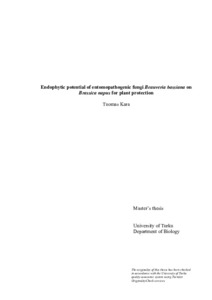Endophytic potential of entomopathogenic fungi Beauveria bassiana on Brassica napus for plant protection
Kara, Tuomas (2021-02-17)
Endophytic potential of entomopathogenic fungi Beauveria bassiana on Brassica napus for plant protection
Kara, Tuomas
(17.02.2021)
Julkaisu on tekijänoikeussäännösten alainen. Teosta voi lukea ja tulostaa henkilökohtaista käyttöä varten. Käyttö kaupallisiin tarkoituksiin on kielletty.
avoin
Julkaisun pysyvä osoite on:
https://urn.fi/URN:NBN:fi-fe202103258391
https://urn.fi/URN:NBN:fi-fe202103258391
Tiivistelmä
To ensure food security for the growing human population sustainable agricultural practices are required. Oilseed rape (Brassica napus L.) is an important crop cultivated worldwide for its oil. Herbivores and disease can cause major damage to the crop and conventional cultivation is dependent on chemical pesticides. Heavy pesticide use has a negative impact on the environment and is not sustainable and thus alternatives are needed. Potential biological tool for pest management are entomopathogenic endophytic fungi such as Beauveria bassiana (Balsamo-Crivelli). These fungi can live asymptomatically inside plants while potentially conferring pest resistance and other beneficial effects. In my thesis I tested whether several strains of an entomopathogenic fungi, Beauveria bassiana, can endophytically establish themselves in B. napus through inoculation of seeds with fungal conidia and whether the seed treatment affected plant growth. A DNA-based method was developed for identification of endophytic establishment. Additionally, I tested whether longer treatment time of seeds with fungal conidia affects endophytic establishment or plant growth. B. bassiana was found to be able to establish itself endophytically in B. napus through seed treatment, although at relatively low rates. Additionally, seed treatment did not have any negative or positive effects on the germination or growth of B. napus. However, longer treatment time of B. napus seeds with B. bassiana had some effects on phenology of B. napus. The entomopathogenic fungi B. bassiana remains a potential candidate for pest management in B. napus cultivation, but more research is required for practical application.
